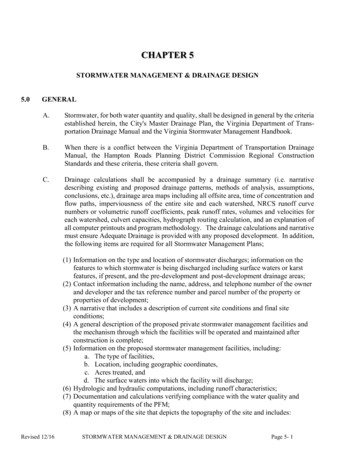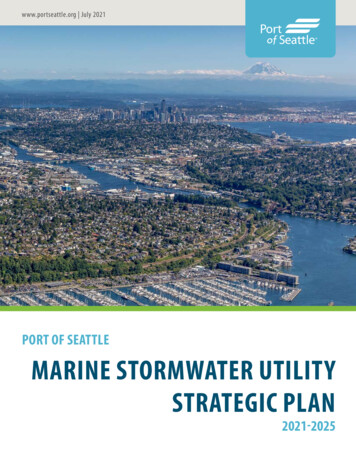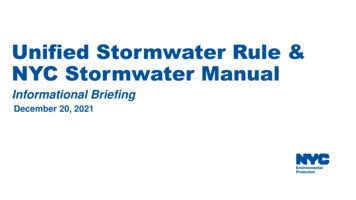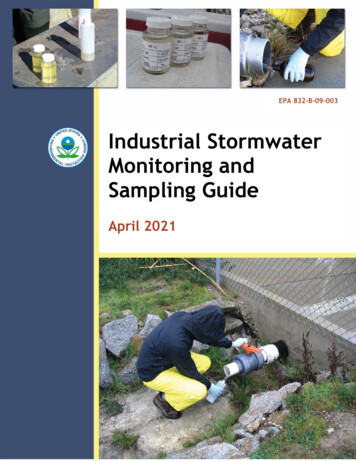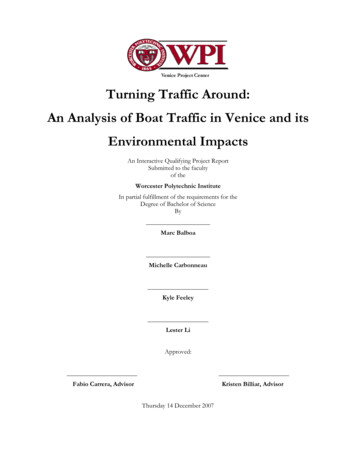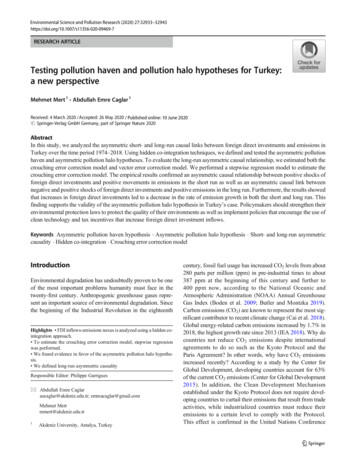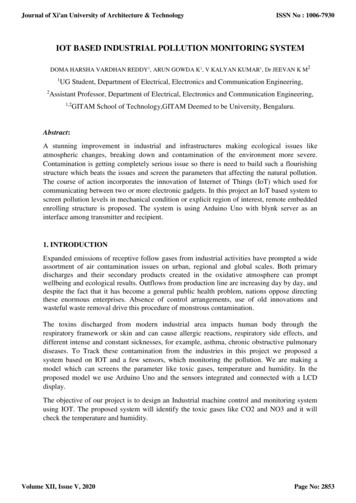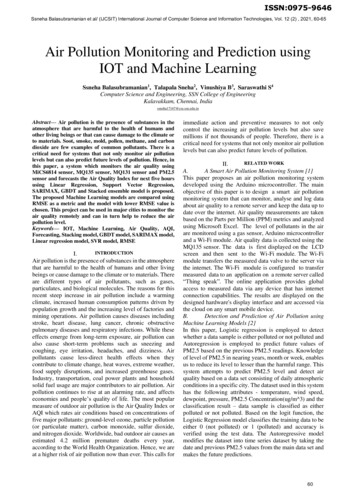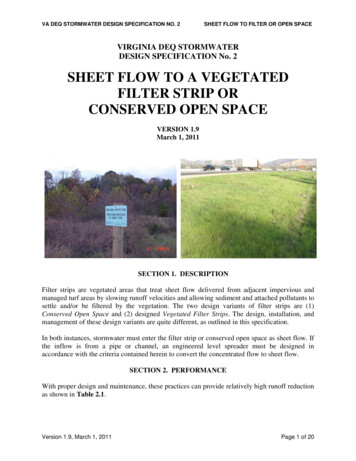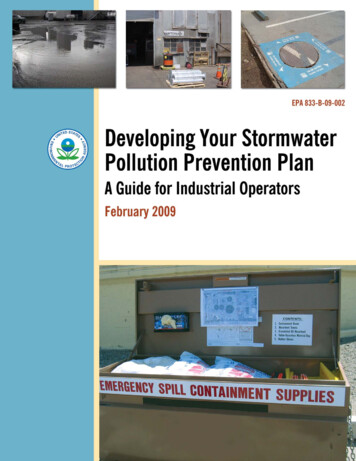
Transcription
ContentsSection 1: Introduction. . . . . . . . . . . . . . . . . . . . . . . . . . . . . . . . . . . . . . . . . . . . .11.A Why Should You Use This Guide? . . . . . . . . . . . . . . . . . . . . . . . . . . . . . . . . . . 11.BWhat Is Stormwater Runoff and What Are Its Impacts?. . . . . . . . . . . . . . . . . . . 1Section 2: Getting Started . . . . . . . . . . . . . . . . . . . . . . . . . . . . . . . . . . . . . . . . . .32.A Am I Required to Develop a SWPPP?. . . . . . . . . . . . . . . . . . . . . . . . . . . . . . . . 32.B What Are the Basic Elements Required in a SWPPP? . . . . . . . . . . . . . . . . . . . . 42.C Stormwater Pollution Prevention Team (Step 1) . . . . . . . . . . . . . . . . . . . . . . . . 52.D What Do I Need to Do to Complete My SWPPP?. . . . . . . . . . . . . . . . . . . . . . . . 6Section 3: Site Assessment and Planning (Step 2). . . . . . . . . . . . . . . . . . . . . . .73.A Conduct an Assessment of the Activities Performed at Your Facility . . . . . . . . . 73.BEvaluate Sampling Data. . . . . . . . . . . . . . . . . . . . . . . . . . . . . . . . . . . . . . . . . . 103.CDevelop General Location and Site Maps . . . . . . . . . . . . . . . . . . . . . . . . . . . . 11Section 4: Selecting Control Measures (Step 3) . . . . . . . . . . . . . . . . . . . . . . . .144.A Minimize Exposure. . . . . . . . . . . . . . . . . . . . . . . . . . . . . . . . . . . . . . . . . . . . 154.BGood Housekeeping . . . . . . . . . . . . . . . . . . . . . . . . . . . . . . . . . . . . . . . . . . . 174.CMaintenance. . . . . . . . . . . . . . . . . . . . . . . . . . . . . . . . . . . . . . . . . . . . . . . . . 184.D Spill Prevention and Response Procedures. . . . . . . . . . . . . . . . . . . . . . . . . . . 184.EErosion and Sediment Controls . . . . . . . . . . . . . . . . . . . . . . . . . . . . . . . . . . . 194.FManagement of Runoff . . . . . . . . . . . . . . . . . . . . . . . . . . . . . . . . . . . . . . . . . 204.G Salt Storage Piles or Piles Containing Salt. . . . . . . . . . . . . . . . . . . . . . . . . . . . 204.H Sector-Specific Requirements. . . . . . . . . . . . . . . . . . . . . . . . . . . . . . . . . . . . . 214.IEmployee Training . . . . . . . . . . . . . . . . . . . . . . . . . . . . . . . . . . . . . . . . . . . . 224.JNon-Stormwater Discharges. . . . . . . . . . . . . . . . . . . . . . . . . . . . . . . . . . . . . . 234.K Waste, Garbage, and Floatable Debris . . . . . . . . . . . . . . . . . . . . . . . . . . . . . . 234.LDust Generation and Vehicle Tracking of Industrial Materials. . . . . . . . . . . . . 244.M Numeric Effluent Limitations Based on Effluent Limit Guidelines. . . . . . . . . . 244.N Additional Controls to Address Impaired Waters . . . . . . . . . . . . . . . . . . . . . . 25Section 5: Procedures for Inspections and Monitoring (Step 4) . . . . . . . . . . .265.A Routine Facility Inspections. . . . . . . . . . . . . . . . . . . . . . . . . . . . . . . . . . . . . . 265.BVisual Assessments. . . . . . . . . . . . . . . . . . . . . . . . . . . . . . . . . . . . . . . . . . . . 295.CAnnual Comprehensive Site Inspections. . . . . . . . . . . . . . . . . . . . . . . . . . . . . 315.D Documentation of Monitoring Procedures . . . . . . . . . . . . . . . . . . . . . . . . . . . 33Developing Your Stormwater Pollution Prevention Plan: A Guide for Industrial Operatorsi
Section 6: Completing Your SWPPP. . . . . . . . . . . . . . . . . . . . . . . . . . . . . . . . . .346.A Finish your SWPPP. . . . . . . . . . . . . . . . . . . . . . . . . . . . . . . . . . . . . . . . . . . . 346.B Obtain NPDES Permit Coverage. . . . . . . . . . . . . . . . . . . . . . . . . . . . . . . . . . . 346.C Updating Your SWPPP. . . . . . . . . . . . . . . . . . . . . . . . . . . . . . . . . . . . . . . . . . 35Section 7: Keeping Records of Your Implementation Activities . . . . . . . . . . . .36Section 8: Common Compliance Problems at Industrial Facilities . . . . . . . . .37Resources. . . . . . . . . . . . . . . . . . . . . . . . . . . . . . . . . . . . . . . . . . . . . . . . . . . . . .39AppendicesAppendix A: MSGP SWPPP Template. . . . . . . . . . . . . . . . . . . . . . . . . . . . . . . . . . . 40Appendix B: Additional MSGP Documentation Template. . . . . . . . . . . . . . . . . . . . . 41Appendix C: Example Site Map . . . . . . . . . . . . . . . . . . . . . . . . . . . . . . . . . . . . . . . 42iiDeveloping Your Stormwater Pollution Prevention Plan: A Guide for Industrial Operators
Section 1: IntroductionThis guide includes suggestions on how to develop a stormwater pollution preventionplan (SWPPP). This guide does not impose any new legally binding requirements onEPA, States, or the regulated community, and does not confer legal rights or imposelegal obligations upon any member of the public. In the event of a conflict betweenthe discussion in this document and any statute, regulation, or permit, this documentwould not be controlling.Interested parties are free to raise questions and objections about the substance ofthis guide and the appropriateness of the application of this guide to a particular situation. EPA and other decision makers retain the discretion to adopt approaches on acase-by-case basis that differ from those described in this guide where appropriate.1.A Why Should You Use This Guide?You should use this guide if you are an operator of an industrial facility requiredto develop a stormwater pollution prevention plan (SWPPP) that complies with aNational Pollutant Discharge Elimination System (NPDES) industrial stormwaterpermit issued by your State or the U.S. Environmental Protection Agency (EPA). Youmay also find this guide to be useful if you are a State or EPA inspector who reviewsSWPPPs, or you operate a commercial facility that is not required to obtain an NPDESpermit but you are nevertheless interested in ways to minimize stormwater-relatedpollution at your facility.Because each State permit can be slightly different, this guide is written more generically in an attempt to make it applicable to as many industrial general permits aspossible. Owners and operators of industrial facilities should carefully read theirrespective industrial stormwater general permit to understandwhere using this guide may conflict with a State SWPPP requirement, and make adjustments to their SWPPPs as needed. EPAincludes additional text describing how to address SWPPPOwners and operators of industrial facilities,requirements that are specifically included in the Agency’s ownwhich are subject to a State or EPA industrial2008 Multi-Sector General Permit (MSGP), the “2008 MSGP”.stormwater general permit typically mustIn addition to helping you develop a SWPPP, this guide alsoincludes sections that will assist you in keeping your implementation records and in avoiding common compliance problems,after you are authorized under the EPA 2008 MSGP or yourState’s general permit. See Section 7 for a discussion of how tokeep implementation records. See Section 8 for a discussion ofcommon compliance problems.develop a SWPPP as a basic requirement. Ifyour facility is subject to such a requirement,failing to develop a SWPPP can result inenforcement action against your facility byEPA or a State! For example, EPA has targetedenforcement actions against some industrialsectors for failing to have developed SWPPPsfor their facilities.1.B What Is Stormwater Runoff and What Are Its Impacts?Stormwater runoff is water from rain or snowmelt that does not immediately infiltrateinto the ground and flows over or through natural or man-made storage or conveyance systems. When undeveloped areas are converted to land uses with impervioussurfaces such as buildings, parking lots, and roads, the natural hydrology of theland is altered and can result in increased surface runoff rates, volumes, and pollutant loads. Stormwater runoff picks up industrial pollutants and typically dischargesthem directly into nearby waterbodies or indirectly via storm sewer systems. Runofffrom areas where industrial activities occur can contain toxic pollutants (e.g., heavyDeveloping Your Stormwater Pollution Prevention Plan: A Guide for Industrial Operators1
Tetra Techequipment. Material spills or losses in theseareas can accumulate and be washed awayduring a storm. Outdoor StorageOutdoor storage activities include storage of fuels, raw materials, by-products,intermediate products, final products, andprocess residuals. Materials may be storedin containers, on platforms or pads, in bins,boxes or silos, or as piles. Storage areasthat are exposed to rainfall and/or runoffcan contribute pollutants to stormwaterwhen solid materials wash off or materialsdissolve into solution.Figure 1. Stormwater runoff can carry pollutants from impervious surfaces toreceiving waters.metals and organic chemicals) and otherpollutants such as trash, debris, and oil andgrease, when facility practices allow exposureof industrial materials to stormwater. Thisincreased flow and pollutant load can impairwaterbodies, degrade biological habitats, pollute drinking water sources, and cause flooding and hydrologic changes to the receivingwater, such as channel erosion.Industrial facilities typically perform aportion of their activities in outdoor areasexposed to the elements. This may includeactivities such as material storage and handling, vehicle fueling and maintenance, shipping and receiving, and salt storage, all ofwhich can result in pollutants being exposedto precipitation and capable of being carriedoff in stormwater runoff. Also, facilities mayhave performed industrial activities outdoorsin the past and materials from those activitiesstill remain exposed to precipitation. In addition, accidental spills and leaks, improperwaste disposal, and illicit connections tostorm sewers may also lead to exposure ofpollutants to stormwater.EPA has identified six types of activities atindustrial facilities that have the potential tobe major sources of pollutants in stormwater: Loading and Unloading OperationsLoading and unloading operations caninclude pumping of liquids or gases fromtankers to storage facilities, pneumatictransfer of dry chemicals, transfer bymechanical conveyor systems, or transferof bags, boxes, drums or other containers by forklift or other material handling2 Outdoor Process ActivitiesAlthough many manufacturing activitiesare performed indoors, some activities,such as timber processing, rock crushing, and concrete mixing, occur outdoors.Outdoor processing activities can result inliquid spillage and losses of material solids,which makes associated pollutants available for discharge in runoff. Dust or Particulate Generating ProcessesDust or particulate generating processesinclude industrial activities with stackemissions or process dusts that settle onsurfaces. Some industries, such as mines,cement manufacturing, and refractories,also generate significant levels of dust thatcan be mobilized in stormwater runoff. Illicit Connections and Non-StormwaterDischargesIllicit connections of process wastes orother pollutants to stormwater collectionsystems, instead of to sanitary sewers, canbe a significant source of stormwater pollution. Non-stormwater discharges includeany discharge from the facility that is notgenerated by rainfall runoff (for example,wash water from industrial processes).With few exceptions, these non-stormwaterdischarges are prohibited. Refer to yourpermit for a list of authorized non-stormwater discharges. Waste ManagementWaste management practices includeeverything from landfills to waste piles totrash containment. All industrial facilitiesconduct some type of waste managementat their site, much of it outdoors, whichmust be controlled to prevent pollutantdischarges in stormwater.Developing Your Stormwater Pollution Prevention Plan: A Guide for Industrial Operators
Section 2: Getting Started2.A Am I Required to Develop a SWPPP?The Clean Water Act (Section 402(p)) requires that operators of “discharges associatedwith industrial activity” obtain a National Pollutant Discharge Elimination System(NPDES) permit. EPA regulations (40 CFR 122.26) define the categories of industrialactivity required to obtain NPDES permits, and specify the application requirementsfor these permits. To regulate stormwater discharges from these industrial activities,EPA and authorized States issue NPDES general permits.Most industrial stormwater discharges are covered under general permits, as opposedto individual permits, although States and EPA can and do issue individual permitsto some facilities based on site-specific or industry-specific concerns. General permitsare used primarily because they avoid the need to issue multiple permits, and insteadonly require a single permit to cover a large number of industrial facilities performingsimilar types of activities. To be covered under a general permit, an eligible operatorof an industry must read the general permit, typically develop a SWPPP, comply withany special eligibility provisions, and submit a notice of intent (NOI) or permit application to the permitting authority.Federal regulations require NPDES permit coverage for stormwater discharges fromthe following categories of industrial activity: Category One (i): Facilities subject to federal stormwater effluent discharge standards in 40 CFR Parts 405-471 Category Two (ii): Heavy manufacturing (for example, paper mills, chemicalplants, petroleum refineries, and steel mills and foundries) Category Three (iii): Coal and mineral mining and oil and gas exploration andprocessing Category Four (iv): Hazardous waste treatment, storage, or disposal facilities Category Five (v): Landfills, land application sites, and open dumps with industrialwastes Category Six (vi): Metal scrapyards, salvage yards, automobilejunkyards, and battery reclaimers Category Seven (vii): Steam electric power generating plants Category Eight (viii): Transportation facilities that havevehicle maintenance, equipment cleaning, or airport deicingoperations Category Nine (ix): Treatment works treating domestic sewagewith a design flow of 1 million gallons a day or more Category Eleven (xi): Light manufacturing (For example, foodprocessing, printing and publishing, electronic and other electrical equipment manufacturing, and public warehousing andstorage).Developing Your Stormwater Pollution Prevention Plan: A Guide for Industrial OperatorsEPA’s 2008 Multi-Sector General Permit (2008MSGP) Applies to a Limited Geographic Area –The 2008 MSGP applies in five States (Alaska,Idaho, New Mexico, Massachusetts, andNew Hampshire), Indian Country lands, mostterritories, and some federal facilities. Alaskawill be taking over administration of stormwaterpermits beginning in 2009. Information onwhere the 2008 MSGP is available is includedas Appendix C of the 2008 MSGP, which can befound at www.epa.gov/npdes/stormwater/msgp.3
Where Do I Get a Copy of the IndustrialStormwater General Permit in My State?2.B What Are the Basic ElementsRequired in a SWPPP?To determine who issues the industrialstormwater permit in your State, you can visitEPA’s stormwater website at www.epa.gov/npdes/stormwater/authorizationstatus orthe Industrial Stormwater Resource Locator atwww.envcap.org/iswrl.A SWPPP is a written document that identifies the industrial activities conducted at thesite, including any structural control practices, which the industrial facility operatorwill implement to prevent pollutants frommaking their way into stormwater runoff.The SWPPP also must include descriptions ofother relevant information, such as the physical features of the facility, and procedures forspill prevention, conducting inspections, andtraining of employees. The SWPPP is intendedto be a “living” document, updated as necessary, such that when industrial activities orstormwater control practices are modified orreplaced, the SWPPP is similarly revised toreflect these changes.Who Is an Operator?EPA defines the operator of an industrial facility as: The entity that has operational control overindustrial activities, including the ability tomodify those activities, or The entity that has day-to-day operationalcontrol of activities at a facility necessary to ensure compliance with the permit(e.g., the entity that is authorized to directworkers at a facility to carry out activitiesrequired by the permit). See definition inAppendix A of the 2008 MSGP.In many cases, the owner and operator areone in the same person. In a few instances,there may be more than one operator at a site(with the owner being an operator based onthe definition provided above). Where there isboth an owner (without operational control)and an operator, it is the operator’s responsibility to obtain permit coverage and complywith the permit provisions. Step 1: Formation of a pollution prevention team of qualified personnel who willbe responsible for preparing the plan andassisting the plant manager in implementing practices to comply with the permit; Step 2: Assessment of potential stormwaterpollution sources; Step 3: Selection of appropriate controlmeasures that minimize the discharge ofpollutants during storm events for each ofthese sources; and Step 4: Development of procedures forconducting required inspection/monitoringactivities, as well as regular maintenanceof control measures.What is a SWPPP?A SWPPP is a site-specific, written documentthat: Identifies potential sources of stormwaterpollution at the industrial facility; Describes stormwater control measures thatare used to reduce or eliminate pollutantsin stormwater discharges from the industrialfacility; and Identifies procedures the operator will useto comply with the terms and conditions ofthe 2008 MSGP or a State general industrialstormwater permit.You are required to develop your SWPPP toaddress the specific conditions at your site andkeep it up-to-date to reflect changes at yoursite both for your use and for review by theregulatory agencies responsible for overseeingyour permit compliance.4The process of developing a SWPPP involvesthe following four steps:This guide will assist you with these foursteps. The selection of a pollution prevention team is discussed in the next section(Section 2.C). Site assessment is addressed inSection 3, the selection of control measures isdiscussed in Section 4, and inspection/monitoring procedures are addressed in Section 5.The remaining sections of the guide addressimplementation of practices to comply withthe permit and periodic evaluation of yourSWPPP.Prepare your SWPPP before submitting an NOIor permit application for coverage!Developing Your Stormwater Pollution Prevention Plan: A Guide for Industrial Operators
A typical SWPPP includes the followingelements: Stormwater pollution prevention team; Site description; Summary of potential pollutant sources; Description of control measures; Schedules and procedures; Documentation to support eligibility considerations under other federal laws; and Certification of the SWPPP.EPA has developed a model Industrial SWPPPTemplate, which can be found in Appendix A,and on EPA’s website at www.epa.gov/npdes/stormwater/msgp. This template, developedfor permit holders subject to the 2008 MSGP,is available in Microsoft Word and can becustomized to address SWPPP requirementsin different State NPDES permits.Where your facility has other written procedures in place, such as a Spill Prevention,Control and Countermeasure (SPCC) Plan oran Environmental Management System (EMS)developed for a National EnvironmentalPerformance Track facility, your SWPPP canreference the portions of those documents inlieu of duplicating that information in yourSWPPP. In these instances, you should keepcopies of the relevant portions of those documents with your SWPPP.EPA’s 2008 MSGP includes the requirementsfor a SWPPP in Part 5 of the permit.Additional SWPPP DocumentationAfter you become authorized under thepermit, you will need to keep records on anyimplementation activities required under yourpermit, including records related to inspections, maintenance, monitoring results, andcorrective actions. This additional documentation, although separate from the actualSWPPP, should be kept with the SWPPP sothat all of your NPDES stormwater records arefiled in one central location (see Section 7).To assist permittees in their recordkeeping,EPA has developed an Additional MSGPDocumentation template, which is available atwww.epa.gov/npdes/stormwater/msgp. Thistemplate, developed for permit holders subjectto the 2008 MSGP, is available in MicrosoftWord and can be modified as necessary toaddress State-specific permit requirements.2.C Stormwater Pollution PreventionTeam (Step 1)The first step in developing the SWPPP is toidentify the stormwater pollution preventionteam. The stormwater pollution preventionteam is responsible for assisting the facilitymanager in developing the facility’s SWPPPas well as implementing and maintainingstormwater control measures, taking corrective action where necessary to address permitviolations or to improve the performance ofcontrol measures, and modifying the SWPPPto reflect changes made to the control measures. Since industrial facilities differ in sizeand complexity, the number of team memberswill also vary. The stormwater pollution prevention team should consist of those peopleon-site who are most familiar with the facilityand its operations and responsible for ensuring that necessary controls are in place toeliminate or minimize the impacts of stormwater from the facility.A key member of the stormwater pollutionprevention team (for some facilities, thismay be the only member) is the person withprimary responsibility for developing andoverseeing facility activities necessary to comply with the permit. This should be someonewho will be on-site on a daily basis and whois familiar with the facility and its operations.This person will also likely have primaryresponsibility for ensuring that inspectionsand monitoring activities are conducted. If anEPA or State inspector visits the facility, thisperson will be the main point of contact forthe SWPPP.What to Include in Your SWPPPIn your SWPPP, identify the staff members(by name or title) that comprise the facility’sstormwater pollution prevention team as well astheir individual responsibilities. Make sure youkeep this information up-to-date as staff memberschange.Developing Your Stormwater Pollution Prevention Plan: A Guide for Industrial Operators5
2.D What Do I Need to Do to Complete MySWPPP?Consider adding a stormwater managementcomponent to employee job descriptions andannual reviews, as appropriate to specificjobs. Often these requirements complimentexisting tasks such as maintaining a clean workarea; promptly cleaning up spills and leaks;performing regularly scheduled equipmentmaintenance; and properly storing all chemicals,oils, and other liquid pollutants.After identifying your pollution preventionteam, you are ready to complete the next threesteps in the development of your SWPPP: Step 2: Assessing your site and activities(Section 3); Step 3: Selecting control measures(Section 4); and Step 4: Developing procedures for inspections and monitoring (Section 5).Each member of the stormwater pollutionprevention team should have ready access toeither an electronic or paper copy of applicable portions of the industrial stormwatergeneral permit and the SWPPP.Section 6 describes final steps necessary tocomplete your SWPPP and to obtain permitcoverage. Section 7 suggests how recordsrelating to permit compliance should be kept.Qualified Personnel – Members of yourstormwater pollution prevention team and thoseconducting inspections and monitoring activitiesshould be “qualified personnel.” EPA definesqualified personnel as “those who posses theknowledge and skills to assess conditions andactivities that could impact stormwater qualityat your facility, and who can also evaluate theeffectiveness of control measures.”6Developing Your Stormwater Pollution Prevention Plan: A Guide for Industrial Operators
Section 3: Site Assessment andPlanning (Step 2)This section describes how to collect the information needed for your SWPPP. Thisinformation includes: An assessment of the activities performed at your facility – this assessment will helpidentify potential pollutant sources. An evaluation of existing sampling data – a review of sampling data will showwhere past problems have occurred. Preparing maps of your facility – site maps will identify the location of industrialactivities, pollutant sources, control measures, and the direction of stormwater flow.3.A Conduct an Assessment of the Activities Performed at Your FacilityWhat to Include inYour SWPPPThe first step in developing a SWPPP is to gain a thorough understanding ofthe activities conducted and equipment located at your facility to be able toidentify potential pollutant discharge concerns. To complete this step, you willneed to conduct a detailed walk-through of your facility to identify industrialDevelop a list of industrialmaterials or material handling activities exposed to stormwater (see text boxactivities at your site exposedbelow), any stormwater controls already in place at your facility, the directo stormwater. Identify thesetion of stormwater flow through and from your facility, and the location of allactivities on your site map.stormwater outfalls. If possible, you should conduct your walk-through during a rain event so that you can observe the flow of stormwater on your site.In addition to your walk-through, you should communicate with fellow siteemployees who may be more familiar with daily operations than you so that you canthoroughly identify any activities that may contribute stormwater pollutants, but thatmay not be readily visible during a routine walk-through (e.g., to identify activitiesthat are not performed on a routine basis).How Does EPA Define Industrial Materials and Material HandlingActivities?Industrial materials or activities include, but are not limited to: material handlingequipment or activities; industrial machinery; raw materials; industrial production andprocesses; and intermediate products, by‑products, final products, and waste products.Material handling activities include, but are not limited to: the storage, loading andunloading, transportation, disposal, or conveyance of any raw material, intermediateproduct, final product or waste product. See 40 CFR 122.26(g).Developing Your Stormwater Pollution Prevention Plan: A Guide for Industrial Operators7
The facility assessment will reveal locationswhere industrial materials or material handling activities may be contributing stormwater contaminants, and help you identify themost important pollutant sources. The following approach is suggested for completing yourfacility assessment:Identification of Activities Exposed toStormwater. As you conduct your facilityassessment, make a list of the industrialactivities exposed to stormwater (e.g., material storage; equipment fueling, maintenance,and cleaning; cutting steel beams). Note theirlocation so they can be identified on the sitemap.Inventory of Materials and Pollutants. Makea list of the materials and pollutants (e.g.,crankcase oil, zinc, sulfuric acid, and cleaning solvents) associated with each identifiedactivity, including pollutants associated withthese materials, based on how they are stored,handled, disposed, etc. Note whether thesematerials are exposed to stormwater, or havethe potential to be exposed to stormwater. Howmaterials are stored and handled has a bearingon the potential for stormwater pollution.What to Include in Your SWPPPFor each of the activities identified above, createan inventory of the materials associated witheach activity (this may be easiest to do in atable). Identify whether these materials are orhave the potential to be exposed to stormwater.Also, identify any pollutants associated with thesematerials based on how they are stored, handled,disposed, etc.Areas with Spill or Leak Potential. Documentwhere potential spills and leaks may occur,and specify the outfall(s) that could beaffected by such spills and leaks. Documentall significant spills and leaks that actuallyoccurred at exposed areas, or that drained toa stormwater conveyance, in the three yearsprior to the date you prepare or amend yourSWPPP. You should consider spillage andleakage of all types of materials when preparing for and documenting such releases.8What to Include in Your SWPPPIdentify locations of potential spills and leaksthat could contribute pollutants to stormwaterdischarges, and the corresponding outfalls thatwould be affected. Review past records of allsignificant spills and leaks that occurre
You should use this guide if you are an operator of an industrial facility required . to develop a stormwater pollution prevention plan (SWPPP) that complies with a . Category Four (iv): Hazardous waste treatment, storage, or disposal facilities Category Five (v): Landfills, land application sites, and open dumps with industrial .
